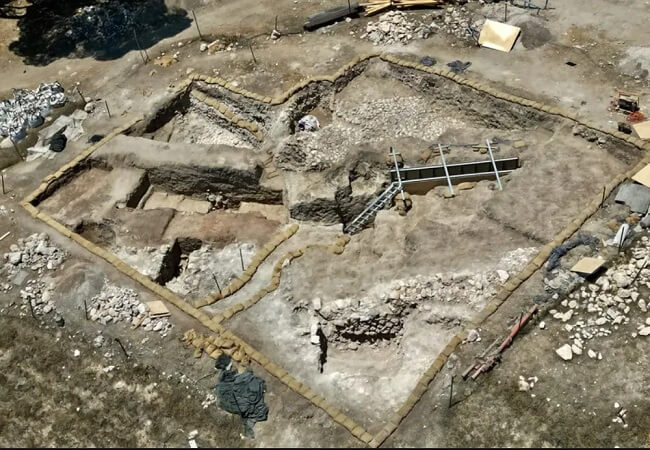
Mysterious 3,800-Year-Old Canaanite Arch & Stairway Unearthed In Israel
Researchers don’t know the purpose of the brick arch, which leads to a set of stairs descending deeper underground
By: Christopher Parker | Smithsonian
Archaeologists have made a stunning—yet thoroughly puzzling—discovery in northern Israel: a 3,800-year-old Canaanite arch and stairway, perfectly preserved underground.
Researchers don’t know the purpose of the structure, which was unearthed at the Tel Shimron archaeological site. They also don’t understand why it was sealed off not long after its construction.
But its preservation is “breathtaking, especially since the building material is unfired (!) mud brick—a material that only rarely survives a long time,” says excavation co-director Mario A.S. Martin, an archaeologist at the University of Innsbruck in Austria, in an email to Live Science’s Sascha Pare.
Archaeologists haven’t historically paid much attention to Tel Shimron. Before the current dig began in 2017, the site had never been extensively excavated. Recently, the team stumbled upon a strange structure that appeared to be man-made.
Evidence Suggests Bob Lazar Was Telling Truth About UFOs & Anti-Gravity Propulsion
“We kept digging down further, and it was preserved at a depth of one meter, then two meters, then three meters, then four meters,” excavation co-director Daniel Master, an archaeologist at Wheaton College, tells the Times of Israel’s Melanie Lidman. “This structure was totally intact, and suddenly we realized we were dealing with the foundation of a building or a superstructure that had been constructed at the top of the site.”
The team uncovered mud brick walls up to 13 feet (4 meters) thick, reports Ariel David of Haaretz. Strangely, no rooms were found within them. Instead, the inside was made up of a long corridor—which led to the mysterious arch. Beyond it, researchers found a staircase leading deeper underground.

Per Live Science, this arch is “corbelled,” meaning it’s made from layers of bricks built gradually inward. This design is sometimes called a “false arch,” while a “true arch” is made with specially shaped bricks that fit together. The Times of Israel reports that the newly discovered arch is the earliest example of corbelled architecture found in the country.
Soon after these structures were built, they were filled with sediment. “Why the passage went out of use so soon is a matter of speculation,” says Martin to Live Science. But the “fact is that it was done with full intent, and not because there was some imminent danger of collapse. For us archaeologists, the quick backfill is the luckiest piece of the whole story, since it is the only reason the feature is so incredibly well preserved almost 4,000 years later.”
These structures date to between 1800 and 1750 B.C.E., when a large Canaanite city stood at the site. The ancient city was an important trading hub mentioned in Egyptian writings at the time.
At first, the researchers thought the walls could have been built to protect the city from outside armies. Ultimately, however, the site’s layout didn’t support that theory.
Now, based on a few clues, they think the building may have been used for cultic purposes. The team found a Nahariya bowl, a type of seven-cupped pottery vessel used for ritual offerings, inside the corridor, per Haaretz. Additionally, thousands of bones belonging to animals that may have been sacrificed were found in a nearby structure.
While many questions remain, the discovery has been exciting for the researchers, who are used to slow, steady progress. “I’m going to spend the next few years convincing my students that this is not archaeology,” Master tells Haaretz. “You just don’t find huge, intact, vaulted passageways you can just walk through.”
In the future, the researchers want to learn more about the mysterious staircase. They plan to eventually “dig down from the other side to try to reach whatever this passage leads to from above,” Master adds. In the meantime, the site has been reburied to protect it from the elements.
* * *
NEXT UP!
Gobekli Tepe: The World’s First Temple?
Six miles from Urfa, an ancient city in south-eastern Turkey, Klaus Schmidt has made one of the most startling archaeological discoveries of our time: massive carved stones about 11,000 years old, crafted and arranged by prehistoric people who had not yet developed metal tools or even pottery. The megaliths predate Stonehenge by some 6,000 years.
The place is called Gobekli Tepe, and Schmidt, a German archaeologist who has been working here more than a decade, is convinced it’s the site of the world’s oldest temple.
* * *
READ MORE: This Ancient Maya City Was Hidden In The Jungle For More Than 1,000 Years
More Archaeology News: Guanches: Ancient Mummies of The Canary Islands (Video)
Enjoyed it? Please take a moment to show your support for Collective Spark.
We’d love to hear from you! If you have a comment about this article or if you have a tip for a future Collective Spark Story please let us know below in the comment section.
